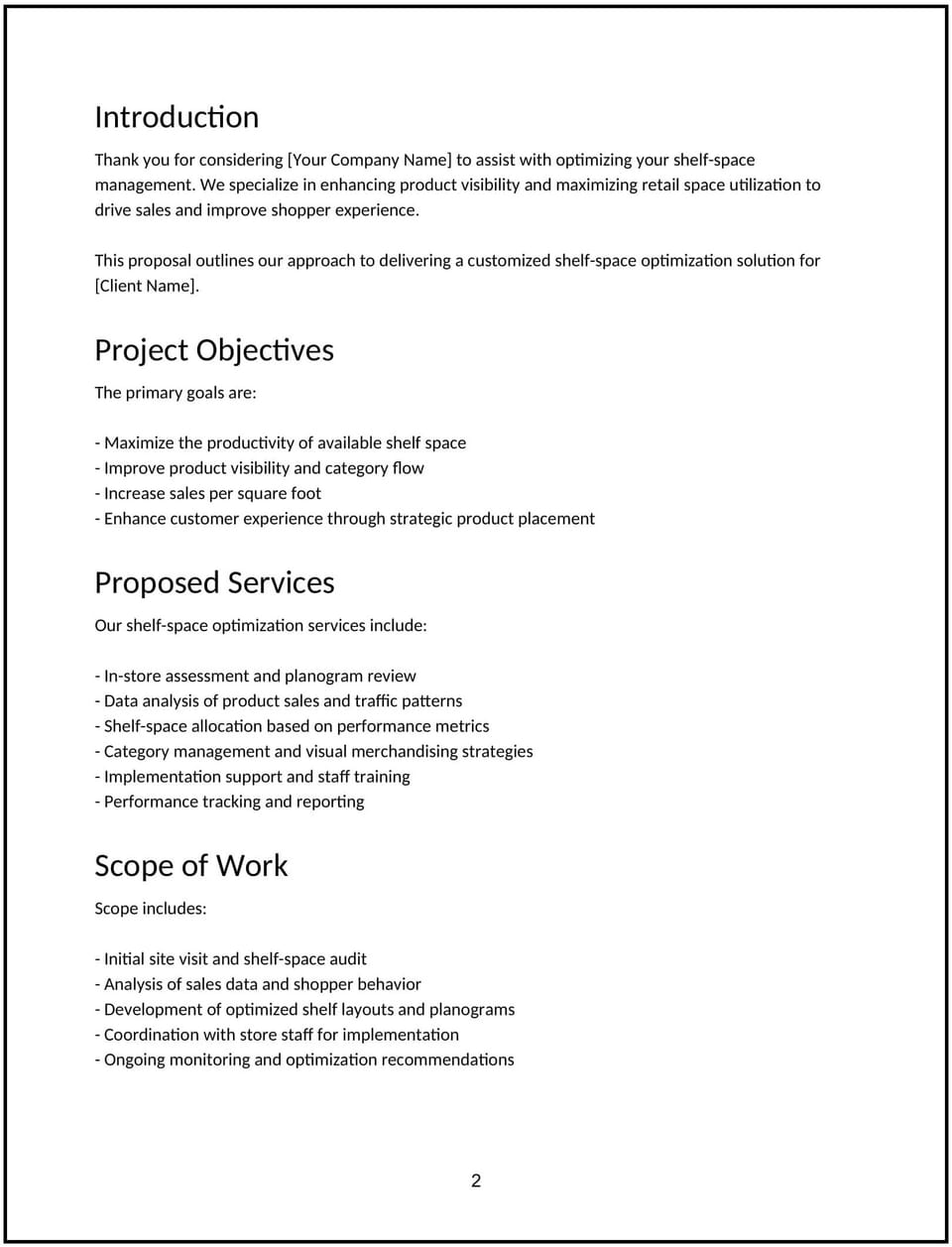Shelf-space optimization proposal: Free template

Customize this free shelf-space optimization proposal with Cobrief
Open this free shelf-space optimization proposal in Cobrief and start editing it instantly using AI. You can adjust the tone, structure, and content based on your analysis, the client’s store format, and product categories. You can also use AI to review your draft — spot gaps, tighten language, and improve clarity before sending.
Once you're done, send, download, or save the proposal in one click — no formatting or setup required.
This template is fully customizable and built for real-world use — ideal for pitching planogram improvements, visual merchandising updates, or data-driven shelf redesigns. Whether you’re consulting for independent retailers or national chains, this version gives you a structured head start and removes the guesswork.
What is a shelf-space optimization proposal?
A shelf-space optimization proposal outlines your plan to improve how products are displayed, categorized, and rotated in a retail environment — with the goal of increasing sales, improving visibility, and maximizing store layout efficiency.
This type of proposal is commonly used:
- After a store walkthrough, sales analysis, or merchandising audit
- To pitch a full planogram redesign or refresh
- When advising clients on how to align space with sales data or customer flow
It helps store owners, merchandising leads, or operators understand how shelf layout choices impact profitability — and how your changes will improve outcomes.
A clear proposal helps you:
- Translate data and observations into visual and financial impact
- Set expectations around timelines, coordination, and execution
- Show that shelf design is a business lever — not just an aesthetic choice
- Align merchandising, operations, and supplier priorities in one plan
Why use Cobrief to edit your proposal
Cobrief lets you edit and enhance this proposal directly in your browser — with built-in AI that helps you sharpen your message and move faster.
- Edit the proposal directly in your browser: No formatting needed — just click and start customizing.
- Rewrite sections with AI: Improve clarity, rephrase for different store types, or tighten explanations with one click.
- Run a one-click AI review: Catch vague phrasing, overused terms, or missing context.
- Apply AI suggestions instantly: Accept line-by-line edits or apply all changes at once.
- Share or export instantly: Send your proposal directly through Cobrief or download a clean PDF or DOCX file.
It’s everything you need to go from draft to decision in less time.
When to use this proposal
Use this shelf-space optimization proposal when:
- Pitching a shelf reorganization to improve sales in underperforming categories
- Responding to a client request for help with visual merchandising or planogram redesign
- Scoping a seasonal layout update to reflect new inventory or promotions
- Advising a multi-location retailer on how to standardize shelving for consistency and performance
- Combining shelf redesign with broader store layout or customer flow adjustments
It’s especially useful when you need to justify changes with data, shopper behavior, or supplier strategy.
What to include in a shelf-space optimization proposal
Use this template to walk clients through the why, what, and how — all in plain-smart language they’ll understand.
- Project overview: Start by summarizing the client’s challenge — whether it’s poor visibility, category imbalance, or supplier pressure — and how your work will address it.
- Objectives and metrics: Define what success looks like — e.g., increased product turnover, better category flow, or improved average basket size.
- Scope of work: Outline the key deliverables — audits, shelf layout designs, planograms, product prioritization, or signage recommendations.
- Methodology: Explain how you’ll approach the project — including data sources (sales, footfall, margins), site visits, or stakeholder interviews.
- Implementation support: Clarify if you’ll be involved in setup, staff coordination, or training.
- Timeline and milestones: Break the project into phases — analysis, design, testing, rollout — with estimated durations.
- Pricing: Show your fee structure — flat, hourly, or phased. Include optional add-ons like reporting dashboards or supplier coordination.
- Next steps: End with a clear CTA — confirm scope, book a walkthrough, or schedule a kickoff.
How to write an effective shelf-space optimization proposal
This kind of proposal should feel practical, commercial, and easy to follow — especially for operators juggling multiple priorities.
- Link shelf changes to real outcomes: Talk about revenue impact, inventory movement, or visual clarity — not just design choices.
- Be specific, not generic: Use the client’s store type, product mix, and pain points to ground your proposal.
- Avoid overcomplicating layout logic: Make the approach feel smart, not academic.
- Highlight collaboration: Note how you’ll work with floor staff, ops teams, or suppliers to implement changes.
- Keep it skimmable: Use short paragraphs and clear sections to help time-strapped decision-makers process it quickly.
- Close with direction: Give the client a simple next step that moves the conversation forward.
Frequently asked questions (FAQs)
Can I use this proposal for different store sizes or formats?
Yes — you can tailor it for small boutiques, supermarkets, big-box stores, or specialty retailers by adjusting the scope and recommendations.
Does this proposal include supplier input?
It can. If supplier influence is relevant, you can add coordination or compliance as part of the scope.
What if the client wants a test layout before full rollout?
You can include a pilot phase — such as optimizing one aisle or location — and use results to guide the full project.
Can I include photos or planograms?
Yes — you can attach visual examples or link to past work to support your recommendations.
Is this proposal a contract?
No — this is a scope and pricing proposal. You can attach or link to a separate service agreement if needed.
This article contains general legal information and does not contain legal advice. Cobrief is not a law firm or a substitute for an attorney or law firm. The law is complex and changes often. For legal advice, please ask a lawyer.